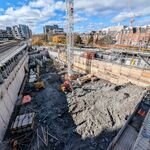Like I've said earlier, you'll see a lot of direct o/d traffic move to rail. Even without HSR. You just a service that is reasonably fast downtown-to-downtown with a reasonable fare and a regular (hourly during the day) schedule. And I've also said, you'll see the airlines cut shoulder schedules. But I'm not inclined to believe that you'll see 37 flights go down to half a dozen. Even with HSR. For a few reasons. First, all rail building is focused on downtown-to-downtown travel. Merely having to transfer at Union, will kill a lot of the time savings and convenience of using long distance rail to get to Pearson. Second, is scheduling. Air Canada runs hourly daytime schedules to Ottawa and Montreal because it provides options to business travellers transfering to long-haul. You will not see this change. Unless you can get rail that's time-competitive to Pearson and has a similar schedule to air service today. How much would it cost to get that kind of rail service? Finally, there's cost. Air France is allowed to put a train between Paris and London and make money selling tickets. If we don't allow that for AC, why would they change their business model? And if that rail ticket costs nearly as much as air fare, it's far more efficient for the airline to have the customer processed in Ottawa or Montreal and shuttled by air to Pearson.
Now, none of that means that rail won't steal a good chunk between Toronto-Ottawa and Toronto-Montreal and particularly Ottawa-Montreal. I can see most o/d traffic moving to rail. I think Porter's business case for Ottawa and Montreal will be dramatically diminished. They'll have to become more focused on the US and Northern Ontario.
One huge issue, that you forget about too is cost. More specifically, who bears the cost. From a govermental perspective, it's a no-brainer to expand an airport, because the government isn't paying for it! The passengers pay for airport development and expansions. Rail on the other hand, means billions in government expenditure, and the real risk that profits might not materialize and subsidies will be needed to maintain service.
I don't know why you assume that a transfer would be necessary at Union. Union is a through station, not a terminus. A train going to Pearson could stop there and then keep going, getting from downtown Montreal to Pearson in around 2:40. That's well within the travel times of air-rail partnership connections in other countries. As for frequencies, hourly or better trains (33 per day in the case of Ottawa) is what was projected in the 1995 feasibility study. If only a third of them go directly to Pearson, that would, again, be consistent with the frequencies offered by other air-rail partnership trips. There's no way that airlines could keep hourly flights going with so many people switching to trains. In the 90s Air Canada themselves estimated that they'd lose close to half their Corridor business to HSR.
Yes, high speed rail would mean billions in government investments. But as I said before, it also means less money put into highway expansion, decreased congestion costs, savings for policing and collisions, less pollution, and increased economic activity from induced trips and increased interconnection between cities.
Good luck selling that message and trying to form government. No party is going to win running on a platform that tells northern Ontario that no infrastructure spending is warranted in their direction. That freeway to Sudbury is as valuable to them as the HSR you want in Southern Ontario. And it's simply potlitically unfeasible to push deliberate spending restrictions on rural areas to boost spending on inter-city rail that runs through their backyards. It's just not going to fly. The sooner we accept that, the sooner we can work around it. This is not just for HSR. Goes for all the urban transit we want too.
The residents of Whistler, BC accepted it just fine. They didn't build a freeway to Whister, they built a cheaper Scandinavian style 2+1 highway. And that highway is significantly busier than Highway 69. I didn't say anything about "no infrastructure spending" in northern Ontario, so that's a straw man. Yes, the freeway is very valuable to Sudbury residents but something like what they built to Whistler would have been just as valuable. Same with non-road based solutions, like having rail instead of freeways like in Australia (their rail and freeway networks are basically the reverse of ours). And let's be honest - 160,000 people in greater Sudbury don't warrant the same infrastructure investment as a million people in London and Kitchener.
Despite their infrastructure choices, politicians in Scandinavia, British Columbia and Australia are still getting elected. Insisting on a freeway to Sudbury is a bit like insisting on a subway on St. Clair. Once you start building it the residents won't accept anything less...but that doesn't mean that better options aren't available.
Paying for a study or even contributing to a $4 billion rail plan is one thing. Contributing to a $20 billion HSR plan is another matter entirely. And the private sector has never said they'll sign up for that. They'll sign up to build it and run it. They won't sign up to finance it. And that's the sticking point. No government is going to want to fund the $16 billion between VIA's current proposal and full HSR. Especially not when that $16 billion buys them so much public transit throughout the country. I'm not even sure, the public would support that. Especially when they know that it's $16 billion less for everything else. This is why I fully agree with VIA's CEO pushing an incremental approach. Far easier to sell HSR when the public is already relying on regular train service. It just sucks that his incremental approach may mean it's 20-30 years before we see real HSR.
Actually the private sector did say that they'd sign up for that, proposing to partially pay for the capital cost. That's what the Lynx proposal was looking to do 25 years ago, which had the backing of half a dozen corporations plus the banks. It was the government that didn't pursue it, not the private sector. The private sector would be part of VIA's proposal as well. Yes, VIA is now pushing an incremental approach out of pragmatism. And with Trudeau in power it actually seems somewhat likely to happen. But VIA was advocating for full HSR until fairly recently.
Only when subsidized and when gas prices are very high. What would fares be in Spain when you include all construction costs (like we would have to)? And how would that compete in a country where gas is $1/L and free parking is still available in many places?
You might want to ask the authors of the feasibility studies that have all shown that HSR in the corridor is viable.
I would love to have HSR. Honestly, would love to have it. And I'd be cheering if Trudeau announced it tomorrow. However, I've just comes to see less of a business case for it, when the difference in cost (between VIA Fast and full HSR) is so huge and opportunity cost is even bigger. For $20 billion, you could have VIA FAST, the DRL, every LRT planned in Toronto and GO RER. And honestly, VIA Fast is good enough. 2.5 hrs Toronto-Ottawa downtown-to-downtown is competitive with air from Pearson and the Island. 3.5 hrs Toronto-Montreal is only slightly slower than downtown-to-downtown from Pearson. And just 1 hr slower than Porter. Depending on cost, there will be enough traffic swayed.
I am going to bet that VIA Fast will be announced in the new year (by March) and that the feds will call it "high speed" because it's faster than what's there today.
If that happens I'd be all in favour of it. Realistically, a more modest rail expansion is much more likely to happen in the near term. The only true high speed rail option that's looking remotely likely right now is the one to London. Both the VIA proposal and the London HSR, along with GO RER, would build momentum for HSR to Montreal at some point in the future.




